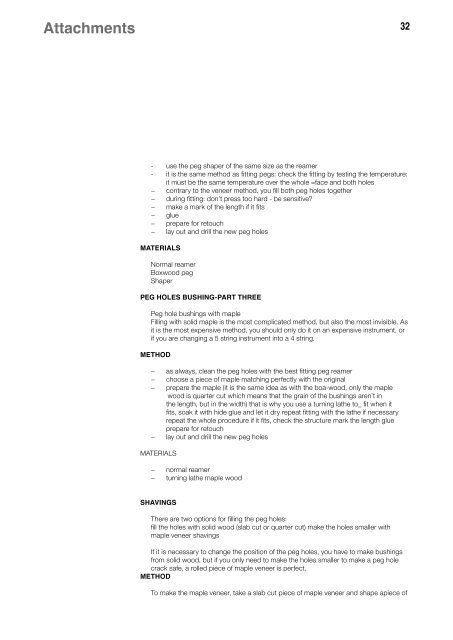advanced violin restoration techniques - International Specialised ...
advanced violin restoration techniques - International Specialised ...
advanced violin restoration techniques - International Specialised ...
Create successful ePaper yourself
Turn your PDF publications into a flip-book with our unique Google optimized e-Paper software.
Attachments<br />
- use the peg shaper of the same size as the reamer<br />
- it is the same method as fitting pegs: check the fitting by testing the temperature:<br />
it must be the same temperature over the whole =face and both holes<br />
− contrary to the veneer method, you fill both peg holes together<br />
− during fitting: don’t press too hard - be sensitive?<br />
− make a mark of the length if it fits<br />
− glue<br />
− prepare for retouch<br />
− lay out and drill the new peg holes<br />
MATERIALS<br />
Normal reamer<br />
Boxwood peg<br />
Shaper<br />
PEG HOLES BUSHING-PART THREE<br />
Peg hole bushings with maple<br />
Filling with solid maple is the most complicated method, but also the most invisible. As<br />
it is the most expensive method, you should only do it on an expensive instrument, or<br />
if you are changing a 5 string instrument into a 4 string.<br />
METHOD<br />
− as always, clean the peg holes with the best fitting peg reamer<br />
− choose a piece of maple matching perfectly with the original<br />
− prepare the maple (it is the same idea as with the boa-wood, only the maple<br />
wood is quarter cut which means that the grain of the bushings aren’t in<br />
the length, but in the width) that is why you use a turning lathe to_ fit when it<br />
fits, soak it with hide glue and let it dry repeat fitting with the lathe if necessary<br />
repeat the whole procedure if it fits, check the structure mark the length glue<br />
prepare for retouch<br />
− lay out and drill the new peg holes<br />
MATERIALS<br />
− normal reamer<br />
− turning lathe maple wood<br />
SHAVINGS<br />
There are two options for filling the peg holes:<br />
fill the holes with solid wood (slab cut or quarter cut) make the holes smaller with<br />
maple veneer shavings<br />
If it is necessary to change the position of the peg holes, you have to make bushings<br />
from solid wood, but if you only need to make the holes smaller to make a peg hole<br />
crack safe, a rolled piece of maple veneer is perfect.<br />
METHOD<br />
To make the maple veneer, take a slab cut piece of maple veneer and shape apiece of<br />
32

















